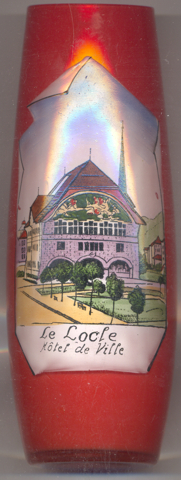

|
| SCHWEIZ / SUISSE / SVIZZERA / SVIZRA | SWITZERLAND |
| Neuenburg / Neuchâtel / Neuchâtel / Neuchâtel |
 Le Locle is situated at an elevation of 920 m about 8 km southwest of
La Chaux-de-Fonds in the canton Neuchâtel of Switzerland.
The municipality has a population of about 10,400 (2017).
Le Locle is situated at an elevation of 920 m about 8 km southwest of
La Chaux-de-Fonds in the canton Neuchâtel of Switzerland.
The municipality has a population of about 10,400 (2017).
The earliest traces of human settlements come from the end of the Mesolithic period (6000–5000 BC) in shelter in the Col des Roches. However, between 4000 BC and the Middle Ages nothing is known about the Le Locle area. In 1150 the valley, in which Le Locle would later be built, was granted to the abbey of Fontaine-André. The heavily wooded portion of the Jura Mountains around Le Locle, were cleared by colonists who later received the status of free peasants. Dou Locle was first mentioned in 1332. The first free farmers received a charter in 1372 which codified their rights and freedoms. At the beginning of the 15th century, this charter was reconfirmed during the foundation of the Mairie or town government. Beginning in the 14th Century Le Locle and La Sagne formed a parish together. The church of Mary Magdalene in Le Locle was built in 1351. As a result of increasing cross-border conflicts, in 1476, Le Locle entered into a defensive alliance with Bern. The Protestant faith was introduced in 1536. In 1707, the Principality of Neuchâtel passed to the kings of Prussia who then ruled Neuchâtel in personal union. During the Napoleonic times, Neuchâtel became French but was restored to Prussia in 1814. One year later, Neuchâtel joined the Swiss Confederation; thus Neuchâtel became the first and only monarchy to join the otherwise entirely republican Swiss cantons. This changed in 1848, when the peaceful Neuchâtel Revolution started in Le Locle. The new republic and canton established the Le Locle Prefecture, which existed until 1935. Le Locle was repeatedly burned by large fires (1683, 1765, 1833). It was rebuilt to its present appearance in the second quarter of the 19th century, as it became a center of the watch industry. Le Locle owes its prosperity essentially to the watch industry, in particular the manufacture of precision watches and machine tools. The watchmaking industry transformed Le Locle into an industrial city. Initially all the work was done by hand in small shops, but by the last quarter of the 19th century the first factories were built. The introduction of mechanized production, pushed the industry from completed watches toward machine tools and watch components. However, the town suffered heavily due to the crisi of this industry in the 1970s. Since then, diversification of the industry has taken place.
The  former town hall (Hôtel de Ville) [left] was built in
1839–1841. Today, it is used as a courthouse.
former town hall (Hôtel de Ville) [left] was built in
1839–1841. Today, it is used as a courthouse.
In 2009, Le Locle and La Chaux-de-Fonds, its sister city, have jointly been awarded
UNESCO World Heritage status for their exceptional universal value.
[https://de.wikipedia.org/wiki/Le_Locle]
![[scale]](lineal.jpg)